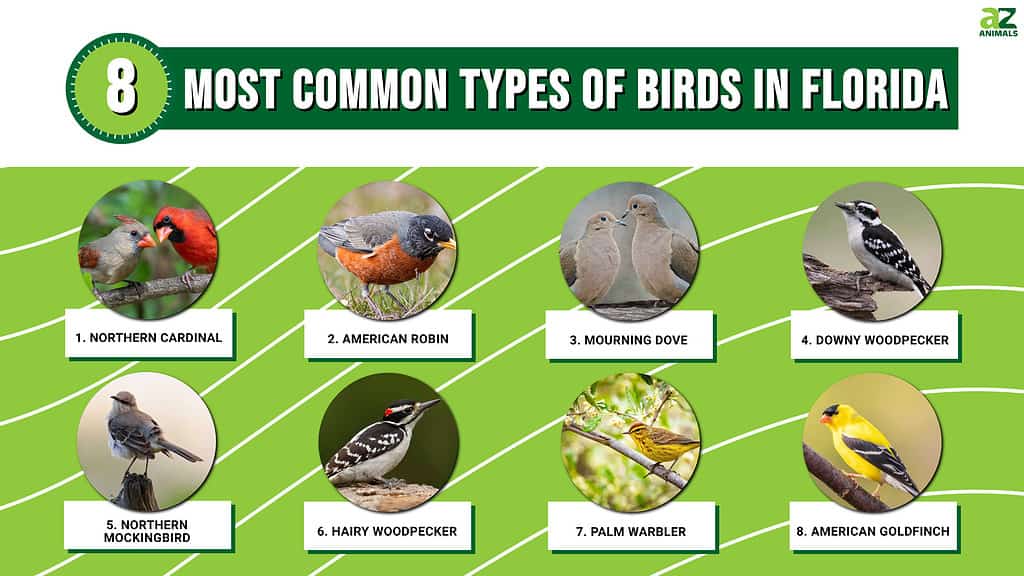
With its forests, prairies, and everglades, Florida is one of the most biodiverse states in the country. Over 500 bird species have been recorded in the state, and some are extremely rare. But others call the Sunshine State home year-round and regularly visit suburban lawns and city parks. Do you have a feathered friend at your backyard feeder you need help identifying? Check out this list of the eight most common types of birds in Florida!
1. Northern Cardinal
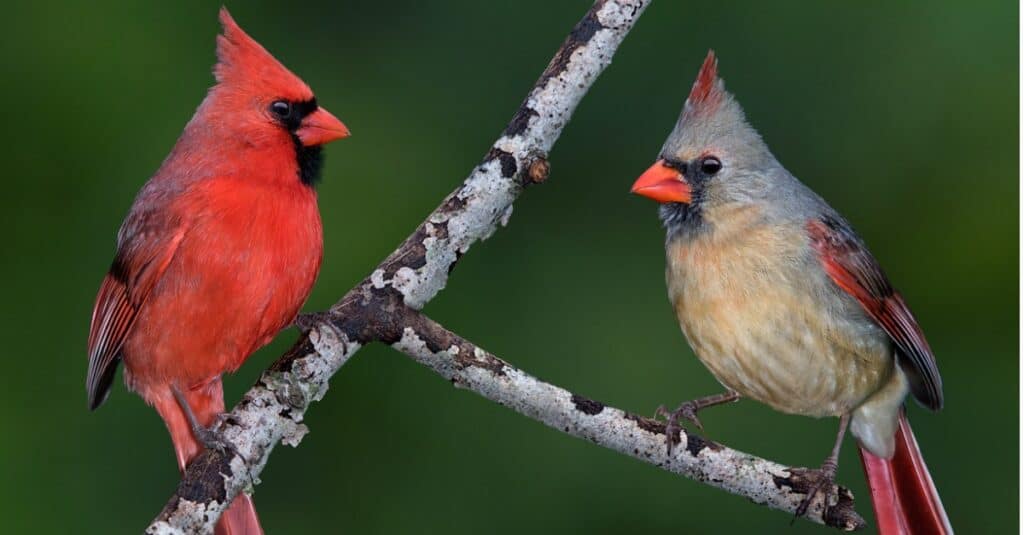
Northern cardinals live year-round in Florida, inhabiting forest edges, marsh thickets, abandoned fields, and backyards.
©Cathy Keifer/Shutterstock.com
Habitat and Range: Northern cardinals are permanent residents in Florida and the rest of the Eastern United States and Mexico. They live in dense shrubby habitats near forest edges, marsh thickets, backyards, and abandoned fields. Look for them in open, high perches.
Features and Coloring: They are relatively large songbirds with prominent crests, long tails, and short, thick bills. Males are brilliant red with black face masks, and females are light brown with red accents.
Diet: They eat a varied omnivorous diet, featuring seeds, fruit, insects, and spiders. However, the majority of their diet is vegetable matter.
Vocalizations: They make clear whistles and slow trills.
Nests: Their nests are well-hidden in thick vegetation. Females construct an open cup made of twigs, grass, and weeds.
Feeder Food: They eat sunflower seeds.
2. American Robin
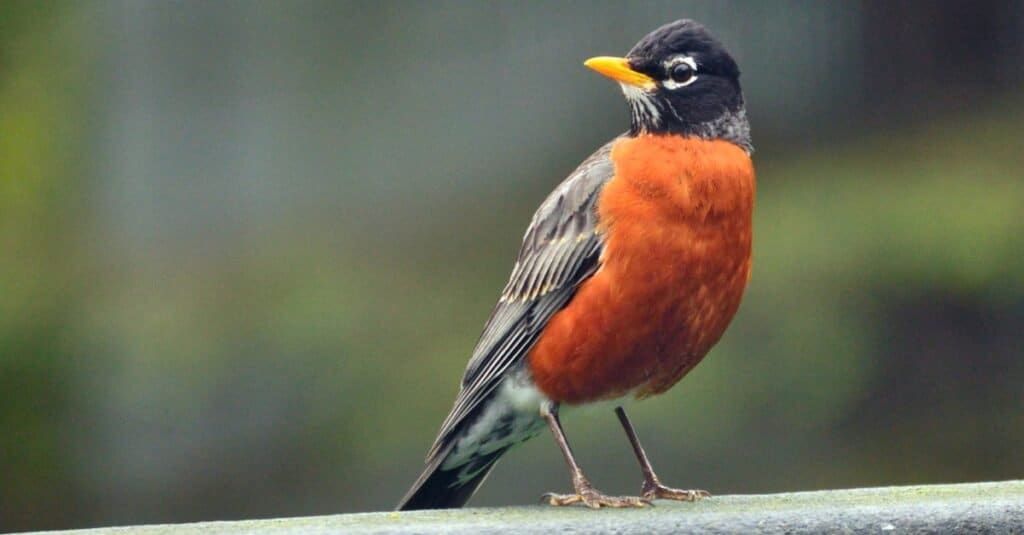
The male
American robin
is generally the last bird heard singing at sunset. They spend winters in Florida and are common around lawns.
©iStock.com/PhotosByMSA
Habitat and Range: American robins spend winters in Florida, except in the panhandle where they live in some areas year-round. They are permanent residents throughout most of the United States. This species lives in common areas across the continent, such as lawns, fields, and city parks.
Features and Coloring: They are fairly large thrushes with round bellies and long legs. Their plumage is grayish-brown above and warm orange below, and their heads are darker than their bodies.
Diet: They eat large quantities of fruit year-round and round out their diet by consuming insects, like earthworms, in the spring and summer.
Vocalizations: They make clear whistles and mumbled calls.
Nests: The nest is a grass and twig cup placed on a horizontal tree branch.
Feeder Food: They eat chopped apples and mealworms.
3. Mourning Dove
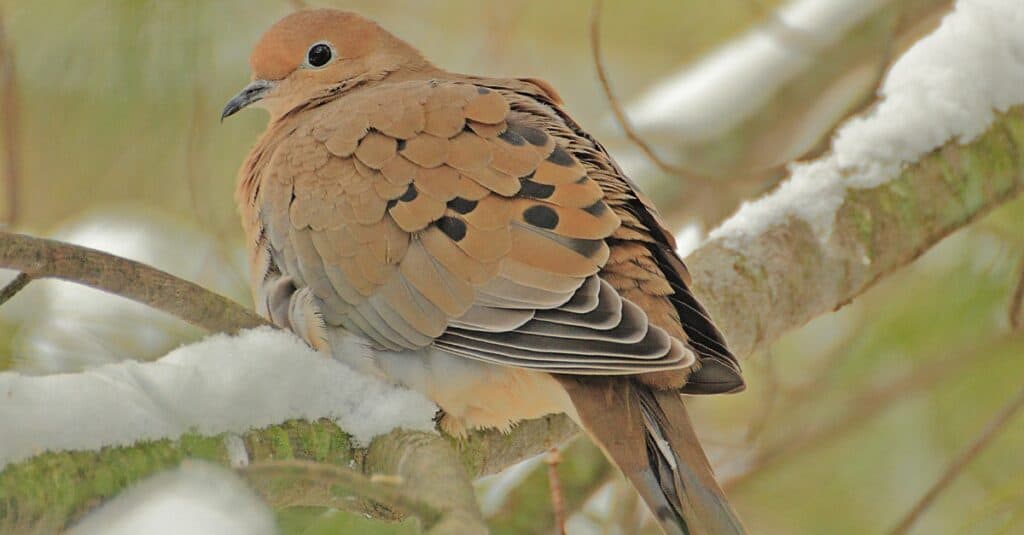
Mourning doves, also known as turtle doves, are commonly found in pairs. They are prolific in the United States and live in Florida all year.
©iStock.com/gregvandeleest
Habitat and Range: Mourning doves are prolific across the United States, where they live all year, including Florida. Populations that breed further north migrate to Mexico and Central America for winter. They live in open country with scattered trees, such as grasslands, backyards, and agricultural fields.
Features and Coloring: They are plump birds with small heads, long tails, and short legs. Their plumage is meant for camouflage and feature buff to brown coloring with black spots on the wings.
Diet: Seeds make up the majority of their diet, but they also consume grains, nuts, weeds, herbs, and berries. They eat snails occasionally, as well.
Vocalizations: They make soft coos.
Nests: A flimsy twig platform placed in a tree or shrub.
Feeder Food: They eat seeds, like millet.
4. Downy Woodpecker
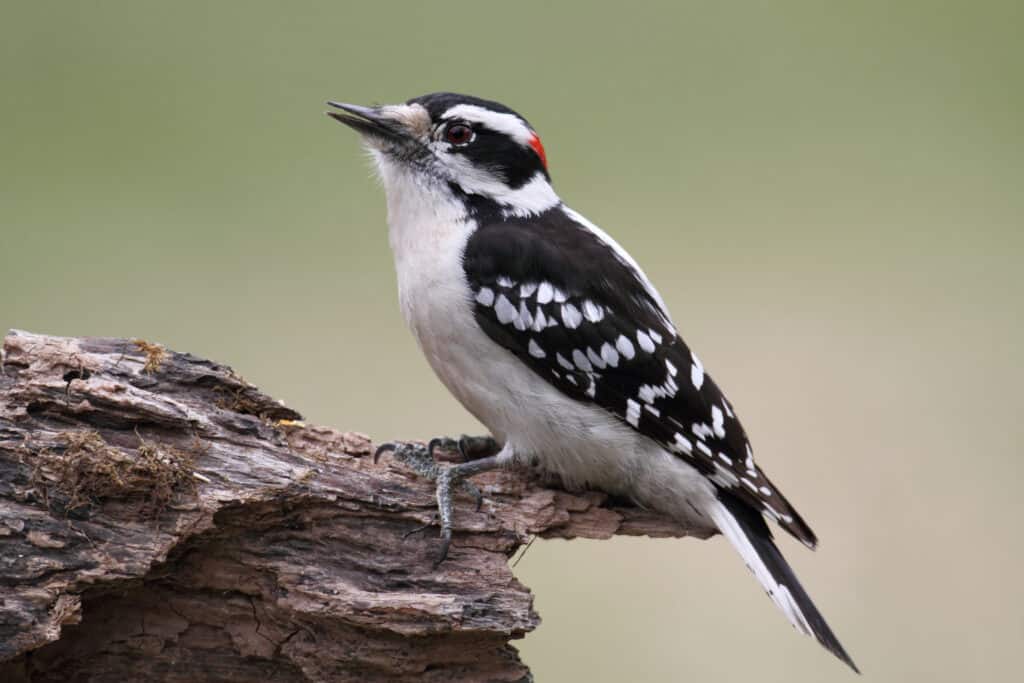
Downy woodpeckers are permanent residents in Florida, where they live along streams, parks, suburbs, and orchards.
©Steve Byland/Shutterstock.com
Habitat and Range: Downy woodpeckers are permanent residents in Florida and the rest of the United States and most of Canada. They prefer deciduous woods along streams but will also inhabit parks, suburbs, and orchards.
Features and Coloring: These small woodpeckers have blocky heads, broad shoulders, and short bills. They have black and white checkered plumage on their bodies and black and white stripes on their heads. Males have a small red patch on the back of their heads.
Diet: They mainly eat insects, especially pests. But they also consume plant material, like berries, grains, and acorns.
Vocalizations: They have hoarse, high-pitched whinnying.
Nests: They nest inside cavities of dead trees
Feeder Food: They eat suet, black oil sunflower seeds, peanut butter, and millet.
5. Northern Mockingbird
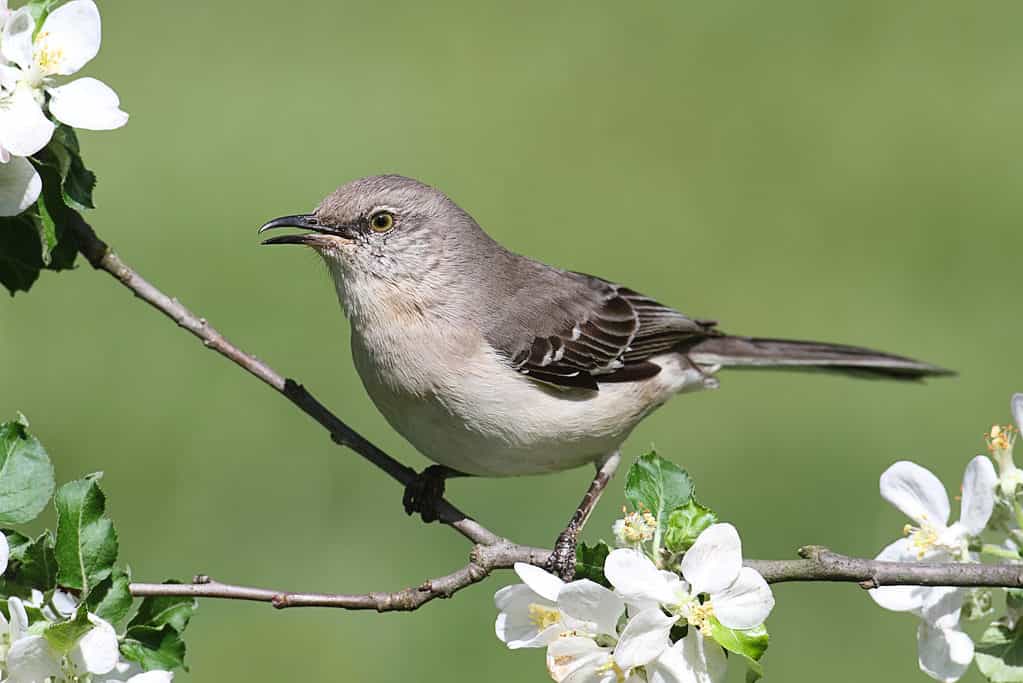
Northern mockingbirds live year-round in the United States and inhabit parks and suburbs. Listen for their whistled songs and mimicry.
©Steve Byland/Shutterstock.com
Habitat and Range: The northern mockingbird lives year-round in Florida and throughout most of the United States and Mexico. They inhabit open areas with shrubby vegetation and are common in parks and the suburbs.
Features and Coloring: Medium-sized and slender, the northern mockingbird has a long tail and a thin, downward-curved bill. They are grayish-brown with pale bellies and white wing bars.
Diet: These birds eat insects during the summer but switch to fruit in the fall and winter.
Vocalizations: They mimic and make whistled songs.
Nests: An open weed and grass cup placed in dense shrubs and trees.
Feeder Food: They eat fruit from trees and bushes.
6. Hairy Woodpecker
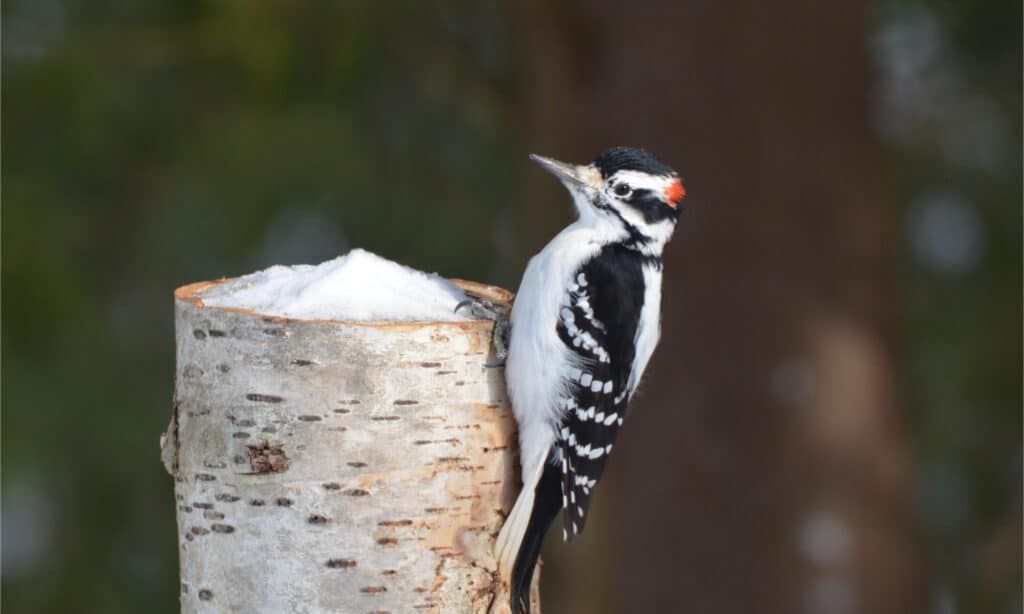
Hairy woodpeckers are slightly smaller than downy woodpeckers. They live permanently in Florida in mature woodlands, parks, and cemeteries.
©C. Hamilton/Shutterstock.com
Habitat and Range: Hairy woodpeckers are another permanent resident in Florida and throughout most of the United States and Canada. Mature woodlands with large trees are their preferred habitats but you can also spot them in parks, suburbs, and cemeteries.
Features and Coloring: These are medium-sized woodpeckers with long, straight bills and stiff tails. They have black and white plumage, checkered on the body and striped on the head. Males also feature red spots on the backs of their heads.
Diet: Insects account for a significant portion of their diet, but around a quarter is preserved for fruits and seeds.
Vocalizations: They make short, sharp notes that are slightly lower-pitched than the downy woodpecker.
Nests: Cavities in deciduous trees
Feeder Food: They eat suet, peanuts, and black oil sunflower seeds.
7. Palm Warbler

The palm warbler winters throughout Florida and breeds in Canada. They live in parks, marshes, prairies, forest patches, and coastal scrub.
©iStock.com/GummyBone
Habitat and Range: Palm warblers breed in Southwestern Canada, migrate through the Eastern United States, and winter in the Southeast, especially throughout Florida. They live in varied habitats, such as parks, marshes, prairies, coastal scrub, and forest patches.
Features and Coloring: They are large warblers with round bellies, long legs, and long tails. They are brownish-olive above and bright yellow below with rusty red caps.
Diet: They mainly eat insects but will supplement their diet with seeds and berries during winter.
Vocalizations: They make buzzy trills and loud smack calls.
Nests: An open cup nest concealed under grass and moss in low trees near the ground.
Feeder Food: They eat nuts and berries suet.
8. American Goldfinch
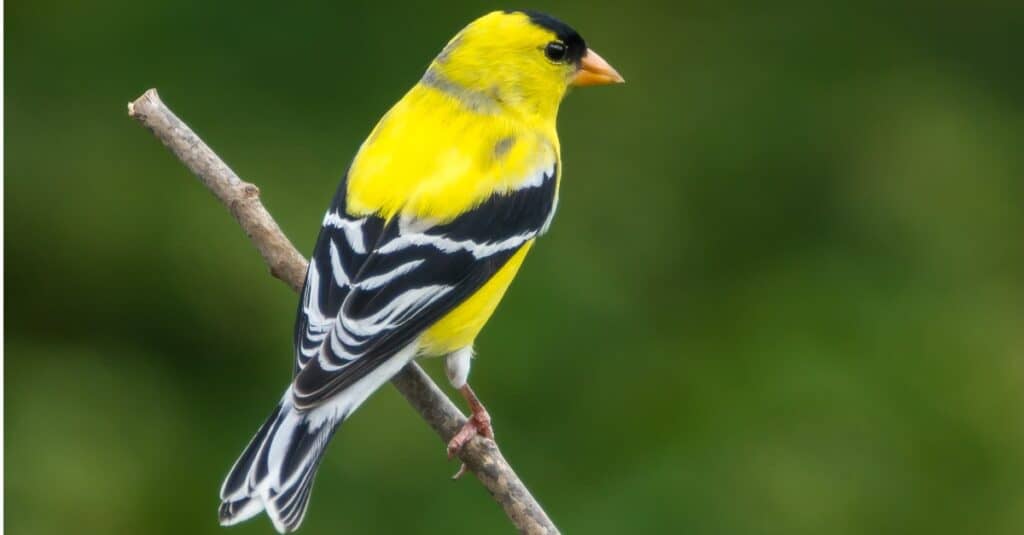
The American goldfinch averages around five inches in length. They are common across the United States, and they winter in the South.
©iStock.com/impr2003
Habitat and Range: The American goldfinch is a common bird across the United States. They breed in Southern Canada and the Northern United States and winter in the Southern United States. Some populations in the Northern US live in their environments year-round. They inhabit weedy fields, suburbs, parks, backyards, and other overgrown areas.
Features and Coloring: They are small finches with notched tails and short, conical bills. Males are bright yellow with black caps and black and white wings. Females are dull yellow below and olive above.
Diet: These birds are exclusive seed eaters and prefer those from composite plants, grasses, and trees.
Vocalizations: They sing long, variable twitters and warbles.
Nests: Their nests are compact cups of plant fiber placed in deciduous shrubs and trees.
Feeder Food: They eat sunflower seeds and Nyjer.
Summary Of 8 Most Common Types Of Birds In Florida
| # | Type Of Bird | Coloring |
|---|---|---|
| 1 | Northern Cardinal | Males are brilliant red with black face masks, & females are light brown with red accents. |
| 2 | American Robin | Their plumage is grayish-brown above & warm orange below, & their heads are darker than their bodies |
| 3 | Mourning Dove | Their plumage features buff to brown coloring with black spots on the wings |
| 4 | Downy Woodpecker | They have black & white checkered plumage on their bodies & black & white stripes on their heads. Males have a small red patch on the back of their heads |
| 5 | Northern Mockingbird | They are grayish-brown with pale bellies and white wingbars |
| 6 | Hairy Woodpecker | They have black & white plumage, checkered on the body & striped on the head. Males also feature red spots on the backs of their heads. |
| 7 | Palm Warbler | They are brownish-olive above and bright yellow below with rusty red caps |
| 8 | American Goldfinch | Males are bright yellow with black caps & black & white wings. Females are dull yellow below & olive above |
The photo featured at the top of this post is © Danita Delimont/Shutterstock.com
Thank you for reading! Have some feedback for us? Contact the AZ Animals editorial team.






